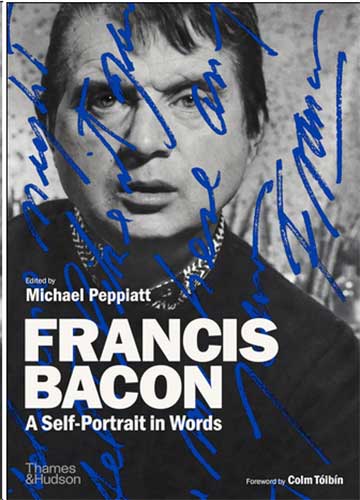
Francis Bacon. A Self-Portrait in Words, ed. Michael Peppiatt
(£40, hbck,Thames & Hudson)
Francis Bacon remains a 20th Century creative giant, an artist who reinvented the human form in paint bringing existentialist angst and chance actions to bear on his obsessive works. Those who argued and continue to argue that his work is somehow horrific or depraved are missing the point: this is oil paint as flesh; slippery, sweaty, viscous, sometimes damaged flesh. The flesh of lovers, friends, popes and others bringing power or violence to bear on others.
It is well documented that Bacon was no saint. He liked rough sex ,gambling, good food and excessive amounts of alcohol. He was nihilist and had little time for flattery or niceties; life was tough and then you died. But first, he had painting to do, attempts at catching what people actually looked like, the essence of their physicality, depicting people in the throes of extreme activities: bullfighting, crucifixions, sado-masochist sex, fights or presiding on thrones or toilets.
He could appear eloquent and informative about his work but a lot of that seems, in retrospect, to be the result of the book of interviews carefully edited and arranged by David Sylvester, juxtaposing information and opinions together from many conversations over more than a decade. That is not, however, to belittle Bacon’s paintings, any more than the plethora of over-the-top academic fawning and opinionated discourses (usually in pretentious artspeak) published over the years can distract from the art itself.
Michael Peppiatt’s selection of statements, letters, studio notes and selected interview, does its best, however, to drown Bacon’s achievements in inanity and mundanity. Here are pages and pages of thank you letters, postcards and scribbled jottings from the studio, presumably found when it was dismantled and moved to Dublin from Kensington. Does correspondence such as ‘Here is the cheque. I do hope the paintings go well’, ‘It was lovely to see you and Stephen again do let us meet more often’, ‘rotten weather but marvellous wine’ or apologetic notes after drunken outbursts the previous day, tell us anything new or interesting about Bacon and his art? I suggest not.
More useful are the gathering of statements from catalogues and other sources, sometimes in draft or annotated form, and the brief selection of interviews – mostly from radio and tv sources – at the end of the book. The inclusion of one from Daniel Farson’s The Gilded Gutter Life of Francis Bacon and another from a San Diego exhibition catalogue are surprising, however, as both are easily available.
This is such a disappointing publication. Bacon is an artist whose work I return to again and again, but little here adds to the documentation already available to readers. There is little revelation about either the art or artist. A much thinner critical anthology would have sufficed and been far more preferable.
.
Rupert Loydell
.
